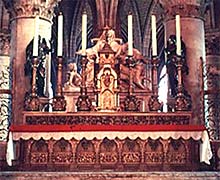 Altar in Notre-Dame, Paris. © Elizabeth A. Peterson The Gothic Cathedral |
An altar is a table or elevated platform intended for the offering of a religious sacrifice. In the religions of ancient times, altars sometimes were composed of the ashes of previous offerings compacted by time. More often, an altar was constructed out of earth or stone. The size of an altar was determined by its specific use. Small altars were used for sacrifices such as the burning of incense; larger altars were required for the offering of animals. Altars were commonly built outdoors, usually in a sacred enclosure in front of a temple.
|
||
In the Christian church, the altar is a tablelike structure that serves as the focal point of worship and on which the Eucharist is celebrated. Although the table, or mensa, is the only essential part of an altar, in Roman Catholic churches other features were added through the centuries: a platform (predella), a canopy, a shelf (retable), a screen (reredos), and a tabernacle (receptacle) for storing the consecrated elements of the Eucharist.
Traditionally, the altar stood at the east end of the church in the center of the sanctuary, and the altar's position determined the orientation of the building. The altar was frequently built over a crypt containing the remains of a saint or martyr. Later, additional altars were sometimes installed along the side walls of a church or in chapels dedicated to saints.
During the Middle Ages, altars were lavished with rich decorations by artists and sculptors. The high altar of Saint Peter's Basilica in the Vatican is highlighted by Bernini's baldachino (canopy), one of the most magnificent altar decorations in Christendom. Many of the best-known examples of Italian and Flemish painting originally formed parts of altarpieces.
The altars in Roman Catholic churches now tend to be simple tablelike structures without decoration and detached from the wall. In Orthodox churches the altar is also freestanding and is separated from the congregation by an iconostasis, or icon screen. Many Protestant churches either have no altar or prefer to refer to it as the Communion table.